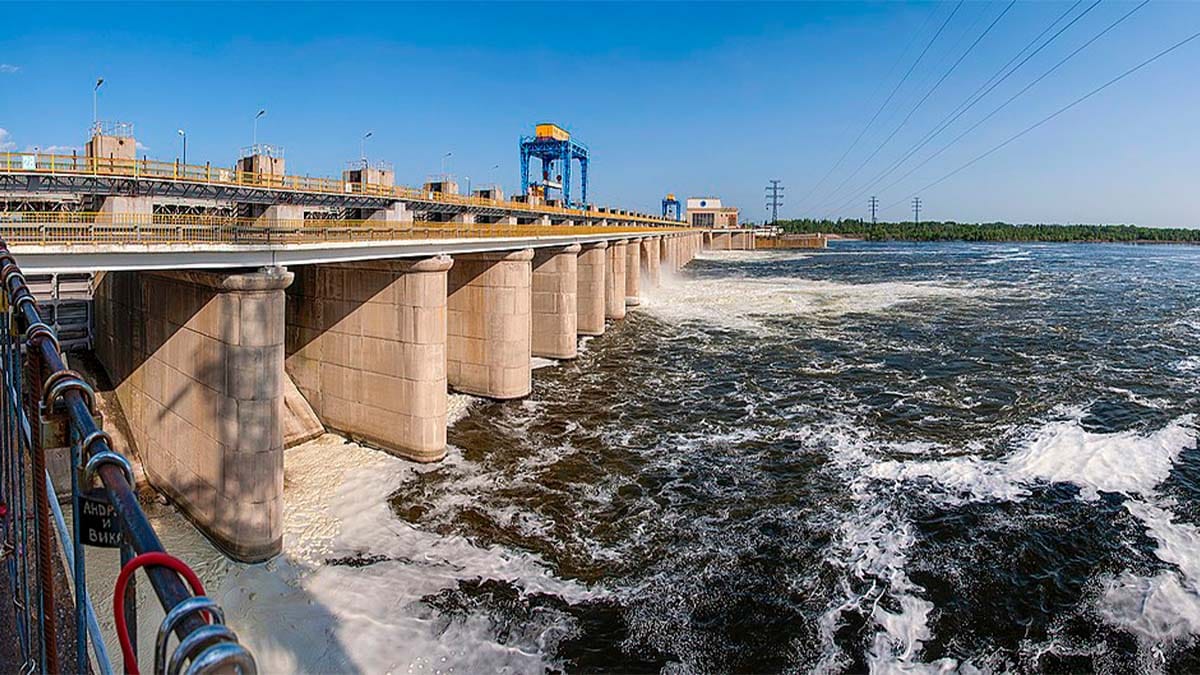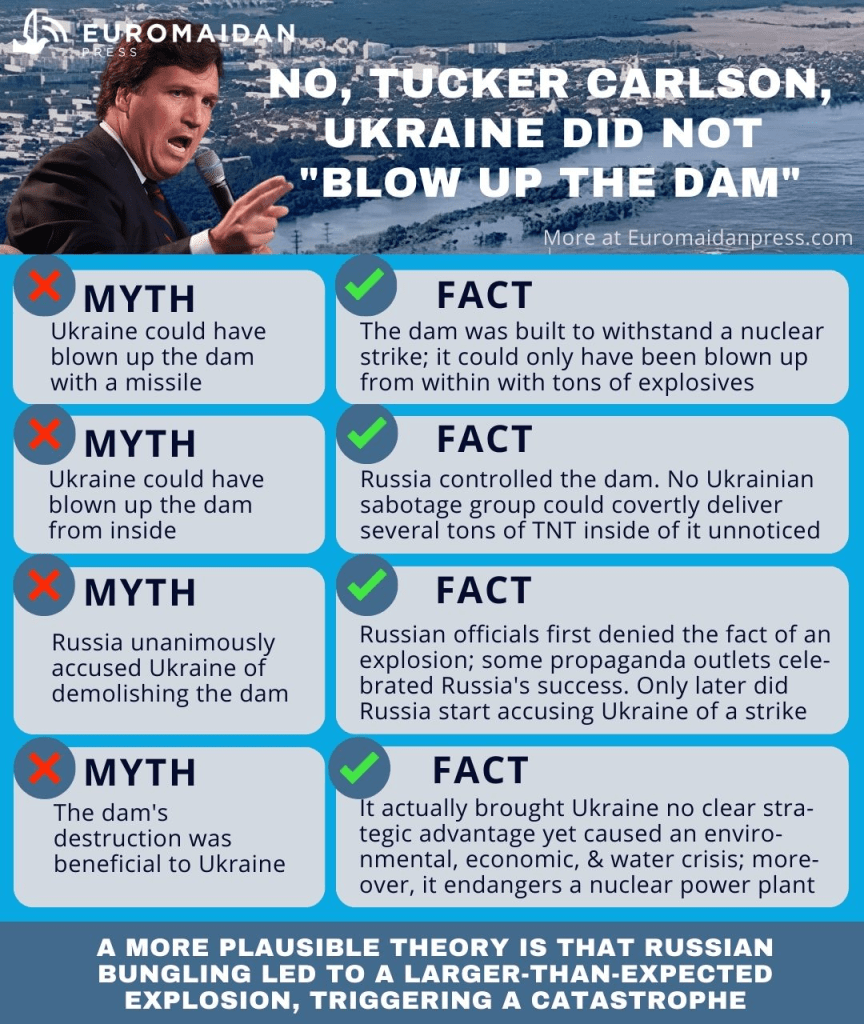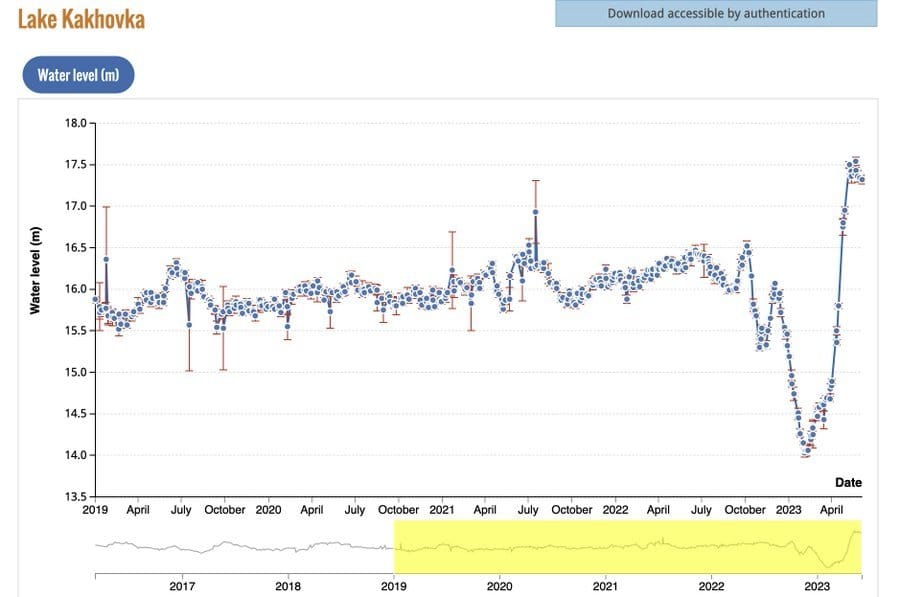The Kakhovka dam: How we know the Russians were to blame

The destruction of the hydroelectric power plant and dam on the Dnipro River in Ukraine on 6th June will probably have been devastating news to readers at the time but something that many will have forgotten about as we become over-satiated by our fill of daily news.
But that catastrophe was as serious as a nuclear bomb being sent into Ukraine. The muted international response does not remotely reflect the seriousness of the event. This was a red line crossed. And yet again, people shouted a lot, then quietly looked the other way.
Before discussing how this event was indeed a red-line war crime in a second article, let me first remove the elephant that may, for some, be lurking in the room.
Ukraine did not blow up their own dam.
This is obviously the narrative that the Russians are sticking to, but that's not how it happened, and there is a Mount Ararat of evidence to support this flood apologetic. Sadly, (though not unpredictably), Tucker Carlson—Fox shackles thrown off and in full unhinged mode—is regurgitating the Kremlin talking points on his new Elon Musk-sponsored show exhibition of bile. As Euromaidan Press reports:
Despite Tucker Carlson’s rant, Ukraine blowing up the Kakhovka dam is akin to shooting itself in the foot. A more plausible theory is that Russian bungling led to a larger-than-expected explosion, triggering a catastrophe....
Mixed in with thinly veiled anti-Semitic comments against President Volodymyr Zelensky, Carlson argues that Kyiv is the most likely culprit since the Kakhovka dam is “Russian,” sits in “Russian” territory, and its destruction hurts Russia the most.
The case for Russian culpability
There are three scenarios posited for who was responsible for the destruction of the dam:
- The Ukrainians blew it up.
- The Russians neglected to look after the dam, and it essentially self-destructed.
- The Russians blew it up.
My conclusion is that there is a combination of both 2. and 3, leaving no doubt that the Russians were fully responsible.
Let us first look to who gained the most from the destruction of the dam. It might be worth noting that the Russians have form here. In 1941, the Soviet Army blew up the predecessor dam on the river to slow down the German troops as they swept through Soviet-era Ukraine. History either repeats or it rhymes pretty effectively.
The Ukrainians were just about to launch their much-anticipated counter-offensive that would look to push the Russians in the south all the way back to Crimea. One direction of attack would be across the front line represented by the Dnipro River over which the dam stretches. Rumors abounded that the Ukrainians were getting ready to attack across the river. Flooding that resulted from the destruction of the dam meant that any counter-attack across the river was now fundamentally delayed or put off indefinitely.
There is a general rule in warfare that attacking armies do not blow things like dams up. This is something done by retreating armies who want to slow down the forces harrying or attacking them. The devastation caused to the environment, Ukrainian people, agriculture (more on this later), industry, culture, and so on is phenomenal. Quite why Ukraine, with a 29% reduction in GDP over the course of the last year already, would have wanted to inflict this upon themselves is beyond any rational thinker.
The Zaporizhzhia Nuclear Power Plant sits on the shores of the reservoir that has now been drained, and its cooling ponds require a certain level of water to be sustained for it to remain safe. Not only would Ukraine certainly not want a Chornobyl 2.0 on their soil, but there is evidence that the Russians have already set up explosives in this energy facility (that is under their control) in an attempt to weaponize it. Russian concern for the safety of the site seems somewhat lacking.
Thus, the circumstantial evidence seems to point irrevocably to Russia having a better justification for blowing up the structure. And I will return in the next piece to the horrific environmental and agricultural impact that this flooding and draining of the reservoir will have on Ukraine going forward.
It is worth noting that, initially, the Russians denied there was an explosion at all at the dam until eventually settling down on the narrative that Ukraine blew it up.
But what of the evidence to support a lack of maintenance for the critical energy infrastructure?
The case for self-destruction
A good account of this hypothesis is given here:
These are the posts the Telegram channel of the Russian 205th brigade made on 21 and 23 October, claiming they mined the Kakhovka dam and are ready for any developments in this area. 16/20 pic.twitter.com/j63hzebd32
— Douggie Fukkew (@MrFukkew) June 6, 2023
The Google Translate of the posts are as follows:

"We mined everything on Kakhovka HPP. So, they'll f**king blow it up and will wash away Ukrainian Armed Forces on the other side" - a Russian says. The video was published on 10 December, 2022. pic.twitter.com/4Eoh0nK0dM
— Anton Gerashchenko (@Gerashchenko_en) June 6, 2023
So we have admissions that the dam was mined by the forces that did it before the event. We also now have intercepts of Russian forces admitting to it after the event. “Our sabotage group was there. They wanted to scare people with this dam. It didn't go according to plan, more than they planned.”
Russian sabotage group blew up Kakhovka dam; it didn’t go as planned, SBU intercept alleges
— Euromaidan Press (@EuromaidanPress) June 9, 2023
Two Russian militarymen are heard discussing the explosion, which is said to be an operation to “scare” that went wrong. https://t.co/VXSCUbWpab pic.twitter.com/cyUMAVrTbI
"It went not as planned, but more than they [the Russian sabotage group] planned." This claim supports the idea that the Russians blew up the dam but that the result was more catastrophic than they had planned, most likely a result of the weakness of the structure from their o wn previous negligence.
More recently, Ukrainian drone footage has emerged of the top of the dam the week before its collapse. There appears to be a roofless car on top of the dam rigged with exp[losives, linked by cable to within the dam:
AP: A week before the explosion at Nova Kakhovka Dam, there was a car with explosives on it.
— Clash Report (@clashreport) June 19, 2023
Image from Ukrainian drone dated May 28 showing a roofless car parked at the dam showing barrels, one of which is connected to a land mine, with a cable going to the right bank. pic.twitter.com/5LLtoGnmbB
A pro-Russian Crimean blogger also claimed that Russians were alerted before the destruction of the dam, contradicting claims that the Russians couldn't have done it because they lost a number of troops positioned downstream:
Talipov claimed that all Russian servicemen had left the islands before the dam was blown up, the Main Intelligence Directorate of the Ministry of Defense of Ukraine or HUR reported on Telegram on June 10.
“Our guys have contacted me. Everyone has left the islands. There was no one there by 3 a.m. There have been no losses. Therefore, all the information being published in this context is a shameless lie,” wrote Talipov.
Such advanced warning and removal of troops from the area only makes sense if the Russians had carried out the attack.
The evidence doesn't stop there. Locals interviewed by mainstream media reported hearing explosions coming from the direction of the dam, beginning at 2:21 am, followed by the sound of rushing water. These claims are triangulated and confirmed by both spy satellite data and seismic data. Concerning the seismic data, New Lines Magazine reports:
The Bukovina seismic array, operated by the Norwegian Seismic Array (NOSAR), detected what researchers at the organization called “clear signals” on Tuesday, June 6, at 2:54 a.m. local time. They concluded that the “recorded signals showed the characteristics of an explosive source,” and that their telemetry from the direction of the dam also recorded “weak signals from an earlier seismic event” at approximately 2:35 a.m.
In addition, a US official said American spy satellites detected an explosion at Ukraine's Kakhovka dam just before it collapsed. The satellites, equipped with infrared sensors, identified a heat signature consistent with a major explosion. This is consistent with the dam being mined as opposed to it failing from a lack of maintenance.
With the dam being under the control of the Russians, there is no realistic way that the Ukrainians could make their way to the other side of the river and get into the facility, lay huge amounts of explosives, and then extricate themselves from the structure and enemy territory on the other side of a major river.
So it appears that there is no rationale or evidence sufficient for anyone of sound mind to believe that the Ukrainians blew up the dam. Tucker Carlson still appears to believe this, so Euromaidan Press has provided a handy cheat sheet for him:

With this now settled, we are in a position to better evaluate the whole situation and see the destruction in terms of a war crime committed by Russia that should be understood as having a greater impact than the use of a tactical nuclear missile. And yet such use of a missile in the war would have been met with unified international condemnation and military action. So why the lack of reaction to the destruction of the dam and subsequent catastrophic flooding?


